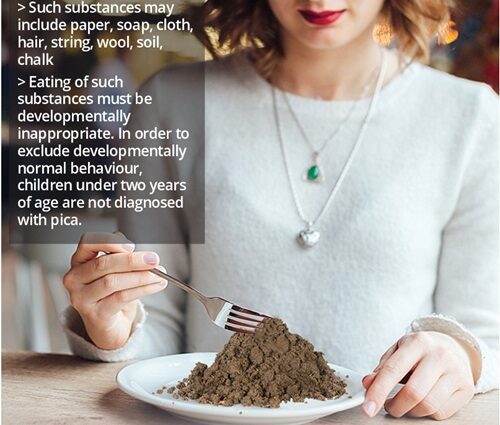Contents
- Definition: what is Pica syndrome?
- Pica syndrome in children, what are the symptoms?
- Pica syndrome and pregnancy: an unexplained phenomenon
- The causes of Pica’s disease, why this need to eat dirt?
- Pica syndrome: what are the risks? Is it bad to eat sand or paper?
- How to treat Pica syndrome: what treatments, what support?
Definition: what is Pica syndrome?
Like anorexia or bulimia, pica disease, or Pica syndrome, akin to a eating disorder. However, this classification is debated because there is no question of food in the context of this syndrome.
Indeed, the Pica is characterized by repeated ingestion of non-food, inedible substances, like dirt, chalk, sand, paper, pebbles, hair etc. Its name comes from the Latin name pica, designating the magpie, an animal known to have this type of behavior.
The diagnosis of Pica is made when a person has persistently eaten non-food substances or objects, repeatedly, for a month or more.
Pica syndrome in children, what are the symptoms?
Pica syndrome can be reminiscent of the behavior of young children. Be careful though: a baby from 6 months to 2-3 years old naturally tends to put everything in his mouth, without it necessarily being Pica’s disease. It is a normal and transient behavior of discovery of his environment, which will eventually pass as the child understands and assimilates what is eaten and what is not eaten.
On the other hand, if the child continues to eat inedible substances past this stage, it may be worth wondering.
In childhood, Pica syndrome most often results in ingestion of soil (geophagy), paper or chalk. In adolescence, Pica syndrome is expressed more by trichophagie, which consists in chewing or ingesting your own hair. It then happens, if this behavior persists, that digestive disorders appear, due to hairballs formed in the stomach.
Both children and adults can be affected by Pica syndrome. There is no particular age to be affected, Pica syndrome is sometimes even observed in pregnant women.
Pica syndrome and pregnancy: an unexplained phenomenon
Without knowing very well why, Pica syndrome can occur during pregnancy. It usually manifests itself by irrepressible cravings for eat chalk, earth, plaster, clay, flour. It could be a reaction ”animal”To fight against nausea, vomiting, deficiencies … Iron deficiency is also often observed, which is why you should not hesitate to talk about it in consultation, to have your iron level checked and take supplementation if needed.
If there are no figures on the frequency of Pica’s disease during pregnancy, however, there is no shortage of testimonials on parental forums.
In some West African societies, and a fortiori in pregnant women of African origin residing in France, ingestion of soil or clay (kaolin, crumbly white clay) is even a kind of tradition, as evidenced by the survey “The taste of clay”, On the geophagy of African women in the district of Château-Rouge (Paris), published in 2005 in the review Land and Works.
“When I found myself pregnant with all my children, I consumed kaolin… It did me good because it does not make you nauseous. In my family all the women did the same”, Testifies in the survey a 42-year-old Ivorian living in Paris.
The causes of Pica’s disease, why this need to eat dirt?
Although not systematic, since cultural traditions or deficiencies may also be at play, Pica syndrome is often associated with psychiatric illness. In children with pica, we often find mental retardation, pervasive developmental disorder (PDD) or autism spectrum disorder, or autism. Pica is then only a symptom of a pathology of another order.
In adults, a mental handicap or significant deficiencies can cause Pica syndrome, while it can be linked to anxiety in children over three years old and in adolescents.
Pica syndrome: what are the risks? Is it bad to eat sand or paper?
The risks associated with Pica syndrome are obviously dependent on the inedible substances that have been ingested. Ingestion of pieces of lead paint can, for example, induce lead poisoning. In the disorder, Pica’s disease can also cause deficiencies, constipation, digestive disorders, intestinal obstruction, parasitic diseases (if the swallowed earth contained parasite eggs for example) or even addiction (to nicotine during ingestion of cigarette butts in particular).
How to treat Pica syndrome: what treatments, what support?
Strictly speaking, there is no specific treatment to overcome Pica syndrome. Finding out what causes this syndrome is essential in determining the best treatment approach.
La psychotherapy can thus be considered, in parallel with changes in the environment of the affected person (replacement of paints, removal of cigarette ends, etc.). In children, it will also be a question of screening for any developmental disorder, mental retardation or autistic disorder.
Medical examinations must also be undertaken in the event of symptoms evoking complications (in particular of a digestive nature, or deficiencies) in order to undertake drug or surgical treatment accordingly.










